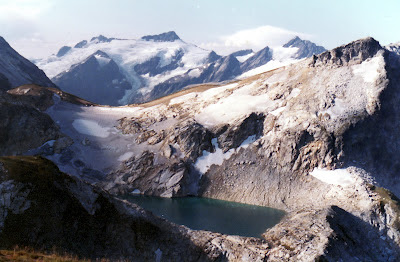
Much like John Muir, I find that “going to the mountains is (like) going home” and that “wilderness is a necessity (for) tired, nerve-shaken, over-civilized people.” And so it was on Friday, August 3, I arrived at Owl Farm for an extended backpacking trip up the Buck Creek Trail in the Glacier Peak Wilderness in Washington.
Having convinced buddies Frank Czubiak, Chuck Ferguson and Steve Still to join me on this wilderness hootenanny, we departed Sunday, August 5 for the trailhead at the old mining community of Trinity. Our goal was to reach Buck Creek Pass, where the views of Glacier Peak (above) and the Dakobed Range are stunning.
A. H. Sylvester, the first supervisor of the Wenatchee National Forest, once wrote that of all the many places he had visited in the Cascades, he thought the most beautiful was Buck Creek Pass at the crest of the Cascades. Having been the wilderness ranger for the U.S. Forest Service in the Chiwawa River area in the 1970s, I must agree.
 Most of us would be testing updated equipment on this trek –- including new packs, stoves and other gear –- which had me thinking about the evolution of backpacking gear since the 1950s.
Most of us would be testing updated equipment on this trek –- including new packs, stoves and other gear –- which had me thinking about the evolution of backpacking gear since the 1950s. Few will recognize the name of this world-renowned pack as a product of the Pacific Northwest, but before the Trapper Nelson, packs were limp canvas sacks equipped with shoulder straps. Only careful packing prevented the contents from digging into a hiker’s back. What’s more: the weight of the pack would sag down on the hips, and the heavier the load, the more the hiker had to bend forward. Lloyd F. Nelson developed and patented the rigid pack board that bears his name in the 1920s, and he is recognized as the one who eliminated discomfort and added pleasure to backpacking.
Few will recognize the name of this world-renowned pack as a product of the Pacific Northwest, but before the Trapper Nelson, packs were limp canvas sacks equipped with shoulder straps. Only careful packing prevented the contents from digging into a hiker’s back. What’s more: the weight of the pack would sag down on the hips, and the heavier the load, the more the hiker had to bend forward. Lloyd F. Nelson developed and patented the rigid pack board that bears his name in the 1920s, and he is recognized as the one who eliminated discomfort and added pleasure to backpacking.I used my Trapper Nelson on numerous excursions, including a 50-mile hike with the Boy Scouts from Timberline Lodge on Mt. Hood to the Columbia Gorge at Cascade Locks.
By the mid-60’s, pack designers had discovered aluminum, so my parents purchased my first regulation Boy Scout pack with an external aluminum frame. By the 80s, I had my first internal frame pack. Today, I sport my “ultralight” rucksack; the current trend, of course, is to “go light.”Pondering the evolution of backcountry gear, I realized that all four of the intrepid hikers –- with an average age of 60 –- had seen generations of backpacking gear. Was my inspiration a case of “trekker antiques?” Or perhaps it was the “antique trekkers” joining me on this wilderness sojourn. Probably both.


No comments:
Post a Comment